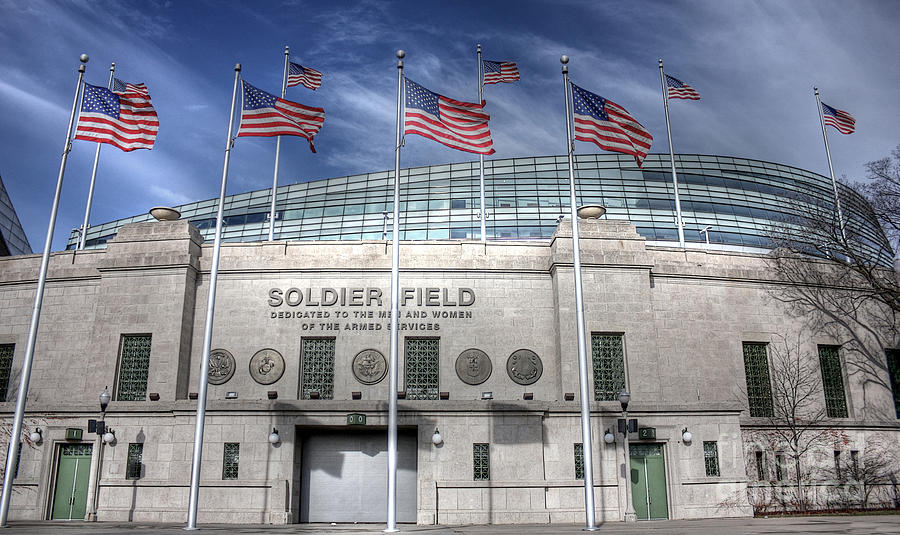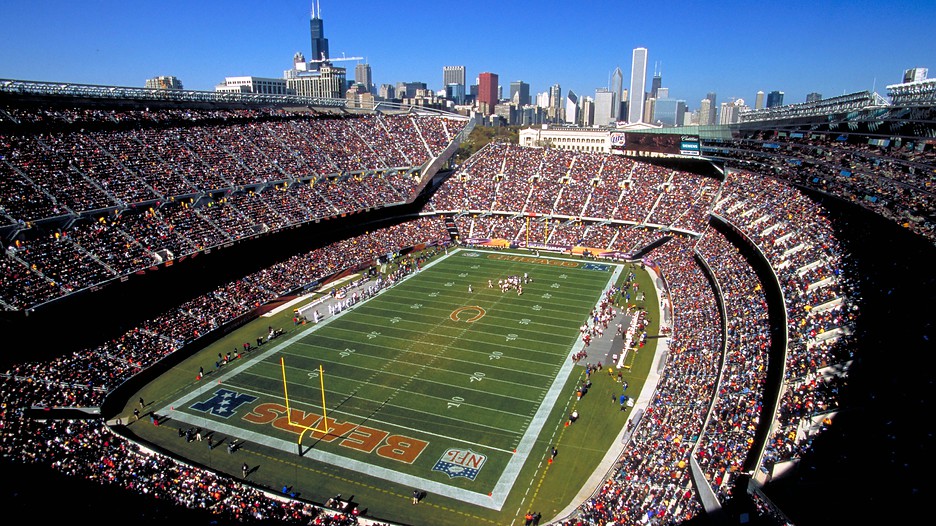October 9, 1924, 100 years ago: Municipal Grant Park Stadium opens on Chicago's lakefront. It would be renamed Soldier Field the next year. It would host many big college football games, including the annual Chicago College All-Star Game between a team of recently graduated players and the defending NFL Champions (who nearly always won) from 1934 to 1976.
And the name is "Soldier" Field. Never "Soldiers" or "Soldiers' Field." There is a Soldiers Field in Boston, part of Harvard University's sports complex.
Its best-known event was the 2nd fight between Heavyweight Champion Gene Tunney and the man from whom he took the title, Jack Dempsey, on September 22, 1927. In the 7th round, Dempsey knocked Tunney down, but he forgot to obey a new rule (which he, himself, had demanded): The referee would not start the count until the standing fighter retreated to a neutral corner. This gave Tunney an extra 5 seconds to regain his bearings, and he got up at the count of 9 (14), and went on to beat Dempsey in a decision.
It became known as the Long Count Fight, and, to this day, some people think Dempsey was robbed. He wasn't: The film clearly shows Tunney watching the referee's count. He could have gotten up at the count of 4, which should have been 9. Dempsey wasn't robbed. He didn't even blow it. He got beat, fair and square. may have had what remains the greatest attendance ever for a U.S. sporting event, with figures ranging from 104,000 to 130,000, depending on who you believe.
It definitely was the site of the largest football crowd ever, 123,000, to see Notre Dame play USC a few weeks after the Long Count. That record stood until a 2016 Tennessee-Virginia game was staged at Bristol Motor Speedway in front of 156,990. The 1926 Army-Navy Game was played there, in front of over 100,000.
The original south side gate. Along with the columns,
it was the only thing saved from the original stadium.
The Chicago Rockets of the All-America Football Conference played at Soldier Field in 1946, '47 and '48, changing their name to the Chicago Hornets in '49. They were not admitted into the NFL with their AAFC brethren in Cleveland, San Francisco and Baltimore. The Chicago Cardinals played their last season there, in 1959, before moving to St. Louis. The Chicago Fire of the World Football League played there in 1974. And the Chicago Blitz of the United States Football League played there in 1983 and 1984.
Amazingly, the Chicago Bears played at Wrigley Field from 1921 to 1970, with the occasional single-game exception. The story I heard is that Bears founder-owner-coach George Halas was a good friend of both the Wrigley and Veeck families, and felt loyalty to them, and that's why he stayed at Wrigley even though it had just 47,000 seats for football.
But I heard another story that Halas was a Republican, and didn't like Chicago's Democratic Mayor, Richard J. Daley (whose son Richard M. later broke his father's record for longest-serving Mayor), and didn't want to pay the city Parks Department a lot of rent. This is believable, because Halas was known to be cheap. The real reason the Bears moved to Soldier Field in 1971 was Monday Night Football: Halas wanted the revenue, and Wrigley didn't have lights until 1988.
Games of the 1994 World Cup and the 1999 Women's World Cup were also held at the old Soldier Field. MLS' Chicago Fire made it their 1st home ground, playing at the old version from 1998 to 2001, and the new version from 2003 to 2005, and returning there starting in 2020.
Amazingly, the Chicago Bears played at Wrigley Field from 1921 to 1970, with the occasional single-game exception. The story I heard is that Bears founder-owner-coach George Halas was a good friend of both the Wrigley and Veeck families, and felt loyalty to them, and that's why he stayed at Wrigley even though it had just 47,000 seats for football.
But I heard another story that Halas was a Republican, and didn't like Chicago's Democratic Mayor, Richard J. Daley (whose son Richard M. later broke his father's record for longest-serving Mayor), and didn't want to pay the city Parks Department a lot of rent. This is believable, because Halas was known to be cheap. The real reason the Bears moved to Soldier Field in 1971 was Monday Night Football: Halas wanted the revenue, and Wrigley didn't have lights until 1988.
Games of the 1994 World Cup and the 1999 Women's World Cup were also held at the old Soldier Field. MLS' Chicago Fire made it their 1st home ground, playing at the old version from 1998 to 2001, and the new version from 2003 to 2005, and returning there starting in 2020.
Soldier Field during the 1994 World Cup
A 2002-03 renovation, during which the Bears played "home" games at the University of Illinois' Memorial Stadium in Champaign, demolished all but the south gate, and the iconic (if not Ionic, they're in the Doric style) Greek-style columns that used to hang over the stadium, and are now visible only from the outside. It doesn't look like "Soldier Field" anymore: One critic called it The Eyesore on the Lake Shore.
Capacity is now roughly what it was in the last few years prior to the renovation, 61,500. And while the Bears won 8 Championships while playing at Wrigley (it took the Cubs until 2016 to win even 1 title there), they've only won one more at Soldier Field, the 1985 title capped by Super Bowl XX. The Monsters of the Midway have been tremendous underachievers since leaving Wrigley, having been to only 1 of the last 38 Super Bowls, and losing it.
The reduced atmosphere, and thus the reduced home-field advantage, may be a part of that, much as similar reductions in atmosphere, passion and on-field performance has been blamed by Washington Redskins/Commanders fans on the 1997 move from the in-the-District Robert F. Kennedy Stadium to the suburban FedEx Field, Yankee Fans on the 2009 move from the old Yankee Stadium to the new one, and Arsenal fans on the 2006 move from Arsenal Stadium (a.k.a. "Highbury") to the Emirates Stadium.
In 2023, the Bears announced a plan to tear down the Arlington Park horse-racing track, 27 miles northwest of the Loop in Arlington Heights -- nearly twice as far from downtown as O'Hare International Airport -- and build a dome there, possibly groundsharing with baseball's White Sox. Nearly every Bears fan was against this.
So an alternative plan was drawn up, to build a stadium on the parkland just south of the current one, keeping the only parts that remained from the original stadium: The columns on each sideline, and the southern gate with its dedication to the military personnel.






No comments:
Post a Comment